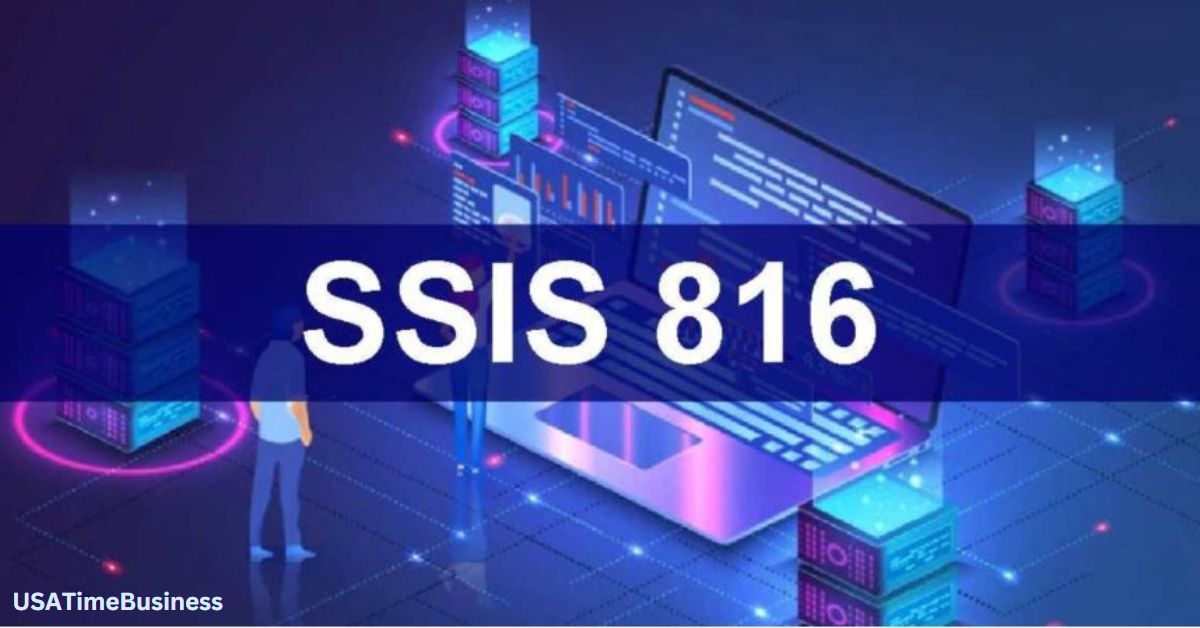Contents
Introduction to SSIS 816
Welcome to the world of data integration, where seamless information flow is critical! In today’s fast-paced digital era, businesses rely on efficient and effective data-handling methods. That’s where SSIS 816 comes into play – your ultimate solution for all things related to data integration. Whether you’re a seasoned professional or just dipping your toes in this vast ocean of possibilities, we’ve covered everything you need to know about SSIS 816.
So, let’s dive right in and explore how this powerful tool can revolutionize your data management processes!
Features of SSIS 816

- SSIS 816 has many features that make it an excellent choice for data integration. One standout feature is its robust connectivity options. SSIS 816 allows you to connect seamlessly to various data sources such as databases, cloud platforms, and file systems.
- Another noteworthy feature is the powerful transformation capabilities offered by SSIS 816. It provides a wide range of transformations, allowing you to manipulate and modify your data during integration. From simple tasks like filtering and sorting to more complex operations like merging and aggregating, SSIS 816 has got you covered.
- Furthermore, SSIS 816 offers exceptional performance optimization features. It allows you to optimize your packages through parallel execution, significantly improving processing speed and efficiency. This means faster data integration and reduced latency in your workflows.
- Additionally, SSIS 816 provides extensive logging and debugging functionalities. You can track the execution of your packages, identify any errors or bottlenecks in the workflow, and troubleshoot them efficiently. These features are invaluable for ensuring the reliability and accuracy of your data integration processes.
- SSIS 816 offers seamless integration with other Microsoft products, such as SQL Server Management Studio (SSMS) and Visual Studio (VS). This tight integration makes it easier for developers to design, deploy, monitor, and manage their ETL workflows within familiar environments.
Benefits of Using SSIS 816
1. Enhanced Performance:
One of the significant benefits of using SSIS 816 is its ability to handle large volumes of data efficiently. Improved parallel processing capabilities can significantly reduce processing time and enhance overall performance.
2. Seamless Integration:
SSIS 816 allows seamless integration with various data sources and destinations, making connecting and extracting data from disparate systems easier. Whether you’re working with databases, flat files, or cloud-based platforms, SSIS 816 provides a unified platform for integrating all your data sources.
3. Flexibility in Data Transformations:
With its extensive set of built-in transformations and scripting options, SSIS 816 offers unparalleled flexibility in transforming your data according to your specific requirements. From simple tasks like cleaning and aggregating data to complex operations such as merging datasets or implementing custom business rules, SSIS 816 gives you the tools to manipulate your data effectively.
4. Robust Error Handling:
Another advantage of using SSIS 816 is its robust error handling capabilities. It allows you to configure error outputs, implement logging mechanisms, and define custom workflows for handling exceptions during the ETL process. This ensures that any errors encountered are adequately managed without compromising the integrity of your data.
5. Scalability:
As your organization’s needs grow and evolve, so do the volume and complexity of your data integration processes. Thankfully, SSIS 816 is designed to scale along with your business requirements by allowing you to distribute workloads across multiple servers or even leverage cloud resources if needed.
Choosing SSIS 816 as your preferred tool for data integration brings numerous benefits, including enhanced performance speeds up ETL processes), seamless integration with various systems (simplifying connectivity), flexibility in transforming & manipulating datasets (customizable transformations), robust error handling capabilities (ensuring accurate results), and scalability (adaptable as business needs change).
How to Get Started with SSIS 816
Getting started with SSIS 816 is a straightforward process that allows you to integrate and transform your data quickly. The steps to get you started are as follows:
1. Installation:
Download the SSIS 816 software from the official Microsoft website. Once downloaded, follow the installation wizard instructions to install it on your system.
2. Configuration:
After installation, open SSIS 816 and configure your connection managers for various data sources such as databases, files, or cloud services. This step ensures that SSIS can access and retrieve data from these sources.
3. Designing Packages:
The next step involves designing packages in SSIS 816’s graphical interface. A package is a collection of tasks that define how data will be extracted, transformed, and loaded into destination systems.
4. Creating Data Flows:
Create data flows Within each package to specify the flow between different tasks or components. Use transformations such as sorting, aggregating, or merging to manipulate the data according to your requirements.
5.Testing and Debugging:
Before deploying your packages for production use, thoroughly test them using sample datasets to ensure they function correctly. Use debugging tools provided by SSIS 816 to identify any errors or issues that may arise during execution.
6. Deployment:
Once testing is complete and everything is working as expected, deploy your packages onto a server that can be scheduled or executed manually based on your needs.
These simple steps give you a solid foundation for utilizing its powerful features.
Common Uses for SSIS 816
SSIS 816, with its powerful features and flexibility, can be used in various ways to streamline your data integration processes. Here are some typical scenarios in which SSIS 816 shines:
1. ETL (Extract, Transform, Load) Operations:
One of the critical uses of SSIS 816 is for performing ETL operations on data. You can easily extract data from various sources such as databases, files, APIs, or web scraping tools. You can manipulate the extracted data to fit your target format with built-in transformation capabilities like cleansing, aggregation, and merging.
2. Data Warehouse Integration:
Many organizations leverage SSIS 816 to integrate their operational systems into a centralized data warehouse. By efficiently loading large volumes of structured and unstructured data into a well-designed schema, businesses gain valuable insights for reporting and analysis purposes.
3. Real-time Data Integration:
For businesses that require real-time updates and synchronization between multiple systems or databases, SSIS 816 comes in handy. It offers robust connectivity options for streaming platforms like Apache Kafka or Azure Event Hubs to ensure the timely processing of events and maintain consistent data across systems.
4. Cloud Integration:
As more companies adopt cloud technologies like Microsoft Azure or Amazon Web Services (AWS), SSIS 816 provides seamless integration with these platforms. When moving workflows to the cloud or integrating with cloud-based services like Azure SQL Database or AWS S3 storage buckets, you can rely on SSIS 816 for efficient connectivity and secure data transfer.
5. Automating Business Processes:
Another everyday use case is using SSIS 816 to automate repetitive business processes involving data movement and transformations. With its visual interface and extensive task library, you can build complex workflows that execute on schedule or trigger based on specific events.
Troubleshooting and Support for SSIS 816
Troubleshooting and support are essential for any software, and SSIS 816 is no exception. If you encounter any issues while using SSIS 816, several resources are available to help you resolve them.
The official documentation for SSIS 816 is a great starting point. It provides detailed information on troubleshooting common problems and offers step-by-step guides for resolving them. The documentation covers installation issues and data flow errors, ensuring you have the necessary information.
In addition to the documentation, there is a vibrant online community of SSIS users who can provide valuable insights and assistance. Forums and discussion boards dedicated to SSIS allow users to share their experiences, ask questions, and receive guidance from experts in the field.
If you prefer more personalized support, Microsoft offers technical support services for SSIS 816. Their team of professionals can help diagnose and resolve complex issues specific to your setup or configuration.
Remember that troubleshooting may require some experimentation and trial and error. It’s essential to keep backups of your packages before making any changes so that you can quickly revert if needed.
Using these troubleshooting resources and support options, you can ensure smooth sailing with your SSIS 816 integration projects. Remember: even experienced users encounter challenges occasionally; it’s all part of the learning process!
Conclusion:
- Effective data integration is essential for businesses to thrive and stay competitive in today’s fast-paced digital world. With data’s ever-increasing volume and complexity, having a reliable and efficient solution is crucial. SSIS 816 has significance in this case.
- SSIS 816 offers a wide range of features, making it an excellent choice for your data integration needs. This tool provides everything you need to efficiently manage your data workflows, from powerful transformation capabilities to seamless connectivity with various data sources.
- One of the key advantages of using SSIS 816 is its versatility. Whether you’re working with on-premises databases or cloud-based solutions, SSIS 816 can handle it. Its compatibility with Microsoft Azure allows you to easily integrate and process data from different sources, enabling real-time insights and decision-making.
- Another significant benefit of choosing SSIS 816 is its user-friendly interface. Even if you need to become a technical expert, this tool simplifies designing and deploying complex ETL (Extract, Transform, Load) workflows. With drag-and-drop functionality and an intuitive visual design environment, users can quickly build robust integration processes without extensive coding knowledge.
- Moreover, SSIS 816 offers advanced debugging capabilities that help identify issues or bottlenecks in your integration pipelines. The built-in logging feature enables detailed monitoring and troubleshooting so that you can ensure the smooth execution of your workflows.
- SSIS 816 has a vast network available regarding support and community resources. From official documentation to online forums filled with experienced professionals ready to lend a helping hand – there’s always a sufficient amount of assistance when working with this powerful tool.
Good luck, Habibi!
Come to the website and explore some mind-blowing content.











